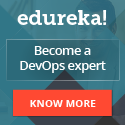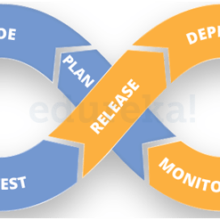Learn about the fundamentals of AWS services such as EC2, ELB, ASG, RDS, ElastiCache, and S3. Discover how to leverage these services to build scalable and reliable applications in the…
Right DevOps Tools selection guide

In this blog post, we will see how you can select and adopt the Right DevOps tools to boost up your career.
you may say that DevOps is no longer talk of the town, but it’s strong standards are adopted by many organizations.
DevOps is composed of:
Culture change – Organizations must adopt the right mindset for DevOps.
They must give teams the responsibilities to push application changes faster into production.
Synergy between developers and operations – This is vital for any organization.
No longer can developers and operations work in isolation. Team members from both sides must work together to carry out agile changes.
Tools – From project planning to deployment, it’s important to choose the right tools in your DevOps lifecycle.
Important and right DevOps tools
There is plenty of a number of tools on the market for DevOps in different areas.
It is important to choose the tools that fit your needs. Each stage in the DevOps lifecycle requires its own set of tools.
A DevOps expert needs to be familiar with the various DevOps tools.
On the Azure platform, an IT professional can pursue the Azure DevOps certification.
This would give an individual better insight into the various DevOps tools.
1.One of the key exams to pass for this certification is the AZ-400 exam
AZ-400: Designing and Implementing Microsoft DevOps Solutions
This exam focuses on the different tools used in DevOps processes. Right from task management to deployment of your applications.
Let’s look at some tools that you can learn to be a stunning asset to your organization to streamline the DevOps process.

This tool is one of the Right DevOps Tools for AWS Aspirants.
What you’ll learn with Right DevOps Tools
- Deploy Spring Applications to multiple environments
- Manage advanced configuration options for Spring
- Create a server on Amazon AWS
- Launch a Docker container
- Configure Jenkins builds
- Configure Artifactory for use
- Deploy Maven build artifacts to Artifactory
- Use MySQL with Spring Boot
There is a lot of fun and challenging content in this course. You will learn more:
- How to manage Spring properties.
- Why you want to encrypt sensitive properties, such as passwords.
- How Spring Profiles are used.
- Using YAML to configure Spring.
- To provision servers on Amazon AWS.
- Logging into your servers via SSH.
- How to use the yum package manager to install software on Linux.
- configure your own Linux service.
- DNS working, and how to use Route 53 to set up your own hostnames.
- How to use webhooks in GitHub to trigger your builds immediately.
- Why you don’t want to use root accounts for your application.
- Configure Jenkins to perform a Maven build.
- Use Jenkins to deploy build artifacts to Artifactory.
This is a very hands on course.
[maxbutton id=”7″]


This is one more one of the Right DevOps Tools using AWS with Terraform.
What you’ll learn with this tool
- You will learn how to deploy a production-scale website on AWS Cloud with Terraform in the real world
course Requirements
- AWS Knowledge at least at the associate level
- Basic knowledge about Terraform and infrastructure as a code in general
- Basic understanding of programming languages, no need to be a programmer though as I will provide you with all the code necessary
- Understanding of how websites work including Domains, DNS, Frontend, Backend, etc
- To be able to implement the project yourself, you will need an AWS Account and PC/Laptop with Windows, Linux, or Mac
Who this course is for:
This course is for aspiring DevOps engineers.
who want to understand how to deploy a highly available, scalable, and performant website on AWS.
with the Terraform and build infrastructure as a code in the real world.
[maxbutton id=”8″]

This tool is the Right DevOps Tool with Jenkins Ansible Docker Kubernetes.
What you’ll learn with this tool
- Complete understanding of DevOps flow.
- Kubernetes setup on AWS cloud
- Setup DevOps CI/CD pipeline to build and deploy a real-time project
Learning Requirements
- Basic knowledge of AWS, Git, Maven, Jenkins, Docker, Ansible, and Kubernetes
- A Desire to learn DevOps workflow
[maxbutton id=”9″]


What you’ll learn with this tool
- DevOps with Docker, Kubernetes, and Azure DevOps from ZERO, no previous experience required
- 6 Most Popular DevOps Tools – Docker, Kubernetes, Azure DevOps, Jenkins, Terraform, and Ansible
- DevOps Building Blocks – Continuous Integration, Continuous Delivery, and Infrastructure as Code
- Implement Azure DevOps Pipelines integrating Docker, Kubernetes, and Terraform on AWS EKS and Azure AKS
- DevOps with Continuous Integration & Continuous Delivery on Azure DevOps and Jenkins
- Containerization and Container Orchestration for Microservices with Docker and Kubernetes
- DevOps with Docker, Docker Compose, and Kubernetes
- Implement Service Discovery, Centralized Configuration and Load Balancing for Docker Microservices deployed in Kubernetes
- Join 450,000 Learners having AMAZING LEARNING Experiences with in28Minutes
Learning Requirements
- You have an attitude to learn while having fun 🙂
- You DO NOT need to have any experience with DevOps, Kubernetes, Docker, or Azure DevOps
- We will help you install the tools and create your cloud accounts on AWS, Azure DevOps, and Google Cloud
- EKS – Kubernetes Clusters on AWS are not part of the free tier. Be careful not to run the EKS clusters for a long time.
- You would need a valid Debit or Credit card to create your cloud accounts on AWS, Azure DevOps, and Google Cloud
[maxbutton id=”10″]
Right DevOps Tools for Project management
DevOps depends on Agile project management philosophy. Teams need tools to help them perform the following tasks:
- Track work items and issues until closing
- Create and visualize user stories
- Know the relation between code commits and work items
- Communicate and collaborate on these work items
Some of the most popular project management tools are:
Atlassian JIRA – This began as an issue-tracking system, but it has matured in the space of Agile project management.
Using Jira, you can define workflows and projects as well as visualize your tasks, issues, and bugs.
Trello – Trello lets you create and visualize your tasks in boards and lists.
You can also prioritize your work with the help of Trello’s built-in features.
Azure Boards – This is part of the Azure DevOps suite of tools.
With it, you can define your work items, visualize them into kanban boards, and track them until they are closed.
Right DevOps Tools for Source code management
Source control software is necessary for software development.
It allows developers to manage several versions of their code and allows them to work in the same code base without overwriting each other’s work.
The most popular source code versioning system is Git.
There are various ways you can host Git repositories. Features of using Git for source code versioning include:
- Decentralized management of your source code
- Local code repositories for each developer
- Tracking of every code change
- A main repository to merge all changes
- Pull requests that allow for peer code reviews before new code emerges
Some popular platforms for hosting Git repositories are:
GitHub – This is by far the most popular platform for hosting Git repositories.
Here you can host both private and public repositories. ‘GitHub hosts a lot of open-source projects.
They also have a server version known as GitHub Enterprise. This allows companies to host their Git repositories on their own servers.
Atlassian Bitbucket – This is an offering from Atlassian for hosting Git repositories.
This also integrates well with other offerings from Atlassian like Jira.
Azure Repos – This is the source code versioning tool from the Azure DevOps services set of tools.
Here you can host both Git repositories and Team Foundation version control repositories.
With Azure Repos, you can easily host Git repositories. Developers can then track all code changes.
Right DevOps Tools for Continuous integration
Teams can use continuous integration tools to perform continuous application builds.
These tools are important to the DevOps lifecycle.
Features of a continuous integration tool include:
- Automated builds of software written in multiple languages
- The ability to build applications on either Windows or Linux environments
- Automated builds and tests whenever there’s a change in the codebase
- Integration with various source code versioning systems
Some popular continuous integration tools include:
Jenkins – Jenkins is open source. It is also one of the first continuous integration tools.
Jenkins has a lot of plugins that provide integration with external systems.
TeamCity – This is also a continuous integration and continuous build tool. With it, you can use build agents to carry out application builds.
Atlassian Bamboo – Bamboo is another offering from Atlassian.
You can either use the cloud version or deploy it to your own servers.
With it, you can create different types of application builds for different environment types.
Travis CI – This is a simplistic solution available for continuous integration.
With Travis CI, you can build code that resides either in GitHub or Bitbucket repositories.
Azure Pipelines – Azure Pipelines provide both build and release pipelines.
With Pipelines, you can define your build with YAML files that can be included in version control with your code.
In Azure Pipelines as shown below, you can create your entire release pipeline.
You get visual representation on each release within your pipeline.
Right DevOps Tools for Testing
Software testing is an important part of the application lifecycle. Don’t make testing an afterthought just because it takes a lot of time. Without testing, you could have an application with many defects.
Some important aspects to consider in testing are:
- Use existing testing frameworks to save a lot of time you would spend writing custom tools.
- Consider using all testing types that apply to your application – unit testing, system testing, user interface testing, and load testing.
- Ensure that testing tools can integrate with your continuous integration phase.
- Have a proper procedure in place for test automation – What are the right testing metrics? How will you measure your test case effectiveness?
Some testing tools to consider include:
NUnit, JUnit – Unit test suites such as NUnit and JUnit help test different units of your code to ensure they will function correctly.
Selenium – Selenium is a popular tool used for user-interface testing. Selenium can also integrate with your continuous integration tools.
“TOP RATED (BEST SELLER) #1 Master SELENIUM java course” -5 Million students learning worldWide with great collaboration
OWASP tools – Security testing is important for web applications.
Understanding threats from the internet is vital.
Use OWASP (Open Web Application Security Project) tools to remove application security vulnerabilities.
SonarQube – Use code analysis tools such as SonarQube during development to detect code issues.
It can find potential performance and memory-related issues in the code development process before you release the code to production.
With SonarQube you get a clear dashboard. The dashboard displays all code-related issues.
Right DevOps Tools for Configuration management
Use configuration management tools to manage the configuration of your technology infrastructure. Large enterprises have complex infrastructures.
Each application and environment has its own credentials and requirements. Configuration management tools track this and ensure that projects deploy correctly.
Features of a configuration management tool include:
- Management of multiple operating systems like Linux and Windows
- Management of both on-premise servers and cloud platforms
- Simplified deployment configuration and management
Some of the popular configuration management tools include:

aws certified security specialist
Chef – This is an open-source configuration management tool.
With Chef, you can define a configuration with the help of pre-existing recipes.
Chef can also integrate with a variety of cloud-based environments.
Puppet – Puppet is a tool to provision your environments and patch your servers.
Ansible – This is a simple configuration management system.
With Ansible, you do not need to define a centralized system to manage your configuration.
PowerShell Desired State Configuration – You can also use PowerShell scripts to manage your virtual machines.
With Azure Automation accounts, you can manage your virtual machine state.
Terraform – Terraform helps you define infrastructure as code. Terraform works with various cloud-based environments.
Vagrant – This software helps build portable virtual software development environments.
Continuous monitoring
Once you have your application environments in place, monitoring those environments is important. Real-time monitoring minimizes application downtime and keeps the user experience free of bugs.
Some important aspects to consider in continuous monitoring are:
- Universal monitoring that can be used in all your environments, whether it is Windows or Linux, in the cloud or on-premises
- A consolidated view of all environments
- Automated report generation and delivery
- Real-time alerts
Some of the popular monitoring tools include:
Datadog – This is a unified monitoring system.
With Datadog you can set up monitoring for your cloud-based and on-premises environments.
It works with both Microsoft Azure and Amazon Web Services.
Nagios – This tool has features that include server, network, and application monitoring.
The Nagios log server allows you to search the log data and create alerts.
Dynatrace – With Dynatrace, you can detect application issues and view application performance metrics in real-time.
AWS CloudWatch – This is the monitoring service available in Amazon Web Services.
With it, you can view resource metrics and performance graphs, create alerts, and store logs.
Azure Monitor – This is the monitoring service available in Microsoft Azure.
With it, you can also stream logs into a central logging repository and get useful insights based on the monitoring data.
Right DevOps Tools for Cloud hosting environments
There are many benefits to using cloud environments for application hosting. They include:
- Reduction in cost – With cloud providers, you only pay for what you need and don’t have to invest in infrastructure.
- Availability of services – Cloud-based providers keep their environments up to date with all the latest technologies.
- Integration with existing resources – If your company has already invested in on-premises environments, cloud-based environments will integrate with them.
The most popular cloud-based providers include:
Amazon Web Services – Amazon is currently the market leader.
Microsoft Azure – Hot on the heels of Amazon Web Services is Azure. Azure has been gaining momentum over the years.
Google Cloud – Google is another up-and-coming cloud provider.
They have a wide range of services that combine with their existing set of development tools.
what is Your end goal?
There are many tools to consider in your DevOps lifecycle. Choosing the right tools can be a challenge. Some questions to ask when looking for the right tools are:
- What application frameworks are you using?
- Are you considering using open source tools?
- Do you have hybrid environments? Are your servers and applications hosted both in the cloud and in on-premises environments?
- How many applications will you be moving into the DevOps lifecycle?
- What technologies are your development teams already familiar with?
Once you can answered these questions, it is much easier to choose the right set of tools for the job.
CHeck out this More devOps titles also
Learn IT and Grow Your career
Agile project management Artificial Intelligence aws blockchain cloud computing coding interview coding interviews Collaboration Coursera css cybersecurity cyber threats data analysis data breaches data science data visualization devops django docker excel flask Grafana html It Certification java javascript ketan kk Kubernetes machine learning machine learning engineer Network & Security nodejs online courses online learning Operating Systems Other It & Software pen testing Project Management python Software Engineering Terraform Udemy courses VLAN web development
-
Understanding and Implementing Gradient Descent in Machine Learning
Introduction In the field of machine learning, the gradient descent algorithm is a fundamental optimization technique used to minimize the cost function of a model. It is widely used in various machine learning algorithms, such as linear regression, logistic regression, and neural networks. In this blog post, we will delve into the conceptualization of the…
-
Designing Software Architectures for the Modern Era of Cloud Computing
Introduction In the modern era of cloud computing, software architecture plays a crucial role in enabling organizations to leverage the full potential of the cloud. With the increasing adoption of cloud services, it is important to design software architectures that are specifically tailored for the cloud environment. In this blog post, we will explore the…











![CMake, Tests and Tooling for C/C++ Projects [2024 Edition] ( Udemy sale, Buy Now! )](https://img-c.udemycdn.com/course/480x270/4628228_4012_2.jpg)






























